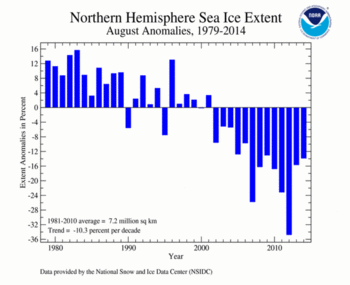Sea Ice Extent
| August 2014 | Sea Ice Extent | Anomaly 1991-2020 | Trend per decade | Rank (36 years) | Record | ||||
|---|---|---|---|---|---|---|---|---|---|
| million km² | million mi² | Year(s) | million km² | million mi² | |||||
| Northern Hemisphere | 6.08 | 2.35 | -5.44% | -11.20% | Largest | 30th | 1983 | 8.19 | 3.16 |
| Smallest | 7th | 2012 | 4.72 | 1.82 | |||||
| Southern Hemisphere | 18.91 | 7.30 | +6.00% | +1.12% | Largest | 1st | 2014 | 18.91 | 7.30 |
| Smallest | 36th | 1986 | 17.00 | 6.56 | |||||
| Globe | 24.99 | 9.65 | +2.97% | -2.18% | Largest | 18th | 1982 | 25.93 | 10.01 |
| Smallest | 19th | 2012 | 22.82 | 8.81 | |||||
Data Source: National Snow and Ice Data Center (NSIDC). Period of record: 1979–2014 (36 years)
According to the National Snow and Ice Data Center (NSIDC), the Northern Hemisphere (Arctic) sea ice extent — which is measured from passive microwave instruments onboard NOAA satellites — averaged for August 2014 was 6.22 million square km (2.40 million square miles), 1.00 million square km (390,000 square miles), or 13.85 percent, below the 1981-2010 average. This was the seventh smallest August Arctic sea ice extent on record, but the largest since 2009. The rate of ice decline during August across the Arctic was slower than average. According to the NSIDC, sea ice extent was below average in nearly all regions of the Arctic, with the exception of the Barents Sea and part of the seas around the Canadian Archipelago, where the Northwest Passage continued to be choked off. The Northwest Passage hasy been ice free only four times in recent history — in 2007, 2008, 2010, and 2011. In the Laptev Sea, the Arctic sea ice extent was much below average, with the ice edge reaching within 5 degrees latitude of the North Pole. The Northern Sea Route was ice free by the end of the month. In the Beaufort and Chukchi Seas, below-average sea ice resulted in the ice retreating to more than 100 miles north of Alaska, considerably farther offshore than in the summer of 2013, but closer to location of the ice edge during other summers of the past decade. The Arctic sea ice extent will continue to decline over the next few weeks, as part of the annual melt season, reaching its annual minimum sometime in September. Overall, August Arctic sea ice extent is decreasing at an average rate of about 10.0 percent per decade.
The August 2014 Southern Hemisphere (Antarctic) sea ice extent was 19.20 million square km (7.41 million square miles), 1.09 million square km (420,000 square miles), or 6.02 percent, above the 1981-2010 average. This was the largest August Antarctic sea ice extent on record, surpassing the previous record set just last year by 240,000 square km (90,000 square miles). This also marked the 20th consecutive month with much above-average sea ice extent in the Southern Hemisphere and the fifth consecutive month with record large sea ice. When examining the Antarctic sea ice extent for all months back to 1979, this was the eighth largest sea ice extent for any month in the period of record. The Antarctic sea ice extent will continue to expand, as part of the annual growth season, reaching its annual maximum in late September or early October. Southern Hemisphere sea ice extent during August is increasing at an average rate of about 1.0 percent per decade.
When combining the Northern and Southern Hemisphere sea ice extents, the globally-averaged sea ice extent during August was 25.42 million square km (9.81 million square miles), 0.36 percent above the 1981-2010 average and the 17th smallest (20th largest) August global sea ice extent on record. This was the largest August global sea ice extent since 2001 and also the first time since 2001 that the August global sea ice extent was above average. Global sea ice extent during August is decreasing at an average rate of about 2.2 percent per decade.
For further information on the Northern and Southern Hemisphere snow and ice conditions, please visit the NSIDC News page.
 NOAA's National Centers for Environmental Information
NOAA's National Centers for Environmental Information

